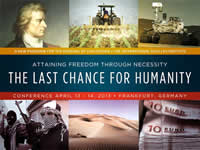 |
The Asteroid-Comet Danger and Planetary Defense:
A View from Russia
by Kirill Benediktov
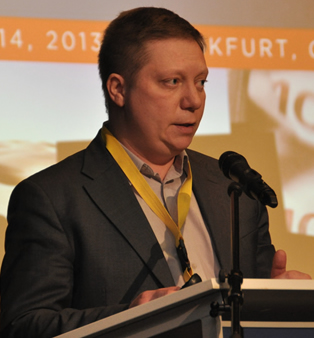 Kirill Benediktov. |
Kirill Benediktov is a writer and a member of the editorial board of the website Terra America. He submitted the paper published here to the April 13-14 Schiller Institute conference, held near Frankfurt am Main, Germany. The version he delivered April 13 was shortened for time reasons; the full translation presented here is supplemented at the beginning by the author’s spoken remarks to the opening session of the conference.
First of all, I would like to thank the Schiller Institute, and Lyndon LaRouche and Helga Zepp-LaRouche personally, for inviting me to speak at this prestigious conference. My prepared remarks begin with a historical overview, but some events that occurred just yesterday have changed my plan. I shall begin, therefore, by telling you what happened yesterday.
Yesterday was April 12, which is marked in Russia, and worldwide, as Astronautics Day, because it was on this day [in 1961] the Russian cosmonaut Yuri Gagarin made man’s first flight into space. Yesterday, it became known that Russian Deputy Prime Minister Dmitri Rogozin had sent a letter to President Putin, proposing to make the keynote topic of the upcoming G20 summit, the prevention of threats from space.
Secondly, President Putin announced that financing for the Russian space program will be increased to 1.6 trillion rubles by 2020. This is quite a hefty figure, essentially comparable with NASA’s budget.
After this short introduction, let me proceed to a characterization of the topic toward which Rogozin has proposed to shift the G20 agenda. This is the problem of the comet and asteroid threat. For quite a long time, mankind has been very sensitive to the existence of a threat from comets. Asteroids, of course, were not yet in the picture. People were thinking about comets, which have quite a frightening appearance because of the tail.
The ‘Horrible Star’: Halley’s Comet and the First Outbreak of Panic, 1910
The first periodic comet known to mankind is the famous Halley’s Comet. Observations of it are depicted in Babylonian astronomical diaries and in Chinese chronicles from the Era of the Warring States [203-221 B.C.]. The fiery “broom star” already then was considered a herald of impending trouble—the Roman Sibylline Books say that the comet will be a “sign of the sword, famine, death, and the fall of leaders and great people.” The appearance of the comet in the Fifth Century A.D. coincided with the invasion of Attila the Hun, and in the 11th Century, with the Norman conquest of England. The latter event is depicted in the famous Bayeux Tapestry (Figure 1). Russian chronicles of the 13th Century talk about “the horrible star,” with its rays extending to the east, the direction from which the Mongol hordes soon invaded Russia.
| Figure 1 The Bayeux Tapestry  |
But it was only in 1910 that the approach of Halley’s Comet first caused a wave of panic, enveloping the entire civilized world. Ironically, this was the direct result of scientific achievements: for the first time, spectral analysis of the comet’s tail was done, revealing the presence of poisonous cyanogen gas, as well as carbon monoxide. It was known that on May 18 the Earth would pass through the comet’s tail, and this sparked a kind of “comet hysteria,” with people waiting for the end of the world. There was panic demand for “anti-comet pills” and “anti-comet umbrellas” (Figure 2). The famous Arthur Conan Doyle, inspired by this lunacy, wrote one of his best science fiction stories, The Poison Belt, in which the Earth passes through a “belt of poisonous ether,” and humanity for a few days becomes immersed in a deep sleep.
Figure 2  |
It is now obvious that the fears of 1910 were unfounded. The concentration of harmful substances in the tails of comets is so low that they do not have any effect at all on the Earth’s atmosphere. Yet at that very time a real, terrible danger was close at hand. Neither scientists nor science fiction writers of that era saw it, although it loudly made its presence known.
From Tunguska to Chelyabinsk: 1908-2013
Two years before the panic caused by the passage of Halley’s Comet, in 1908, something exploded in the very heart of Siberia, near the Podkamennaya Tunguska region. Astronomers cautiously described it as a space object of cometary origin. The force of the explosion was 40-50 megatons, and its effects were seen even in Western Europe, where for several nights there was a ghostly phosphorescence in the sky. The brilliant Russian scientist Vladimir Ivanovich Vernadsky, whose 150th anniversary we celebrate this year, very precisely defined the “Tunguska wonder” as “a clump of cosmic dust” (Figure 3).
Figure 3 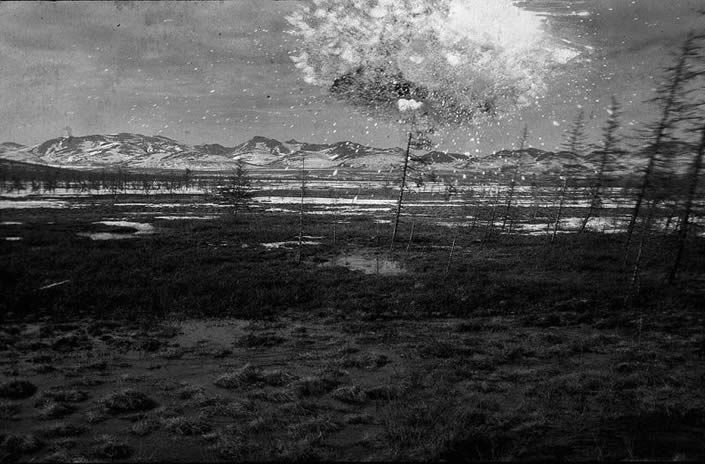 |
But even this “clump of dust,” when it collided with Earth, flattened a forest area of more than 2,000 sq km, and it was only by good luck that there were no casualties. If the object that exploded over Tunguska had come four hours later, as a result of the rotation of the Earth around its axis it would have completely destroyed the city of Vyborg and reduced the beautiful palaces of St. Petersburg to ruins.
That was an ominous warning. But since the disaster befell one of the most uninhabited regions of the planet, rather than densely populated areas of Europe or the Americas, mankind simply ignored it.
Meanwhile, the “shelling” of the Earth from space continued. Especially noteworthy are the “Brazilian Tunguska” of Aug. 3, 1930, when the fall of a celestial body in the rainforest on the border of Brazil, Peru, and Colombia ignited fires that raged for days, and the jungles were depopulated for hundreds of square kilometers; and the Sikhote-Alin meteorite in 1947, whose fragments weighing a total of up to 80 metric tons fell in a meteor shower in the Soviet Far East.
But while these events occurred in sparsely populated areas, an asteroid that nearly exploded over the United States in 1972 could have led to a large-scale catastrophe. With a diameter of 80 meters, it entered the Earth’s atmosphere over the state of Utah, at a speed of about 15 km/s. If it had reached the surface of the Earth, the explosion would have been comparable in scale to the explosion at Tunguska, but instead of the 2,000 sq km destroyed by the Tunguska wonder, this time it would have been right at the center of a high-technology and densely populated country. Fortunately, the trajectory of the asteroid was very shallow, and, after flying above the Earth for 1,500 km, it exited the Earth’s atmosphere over Canada and was lost again in the vastness of space.
The most dramatic was the recent Chelyabinsk incident, when an explosion of a meteoroid over Chelyabinsk injured at least 1,613 people, mostly with minor traumas and cuts (Figure 4). The meteoroid itself was relatively small—about 17 meters in diameter and weighing about 10,000 metric tons (Figure 5).
Figure 4 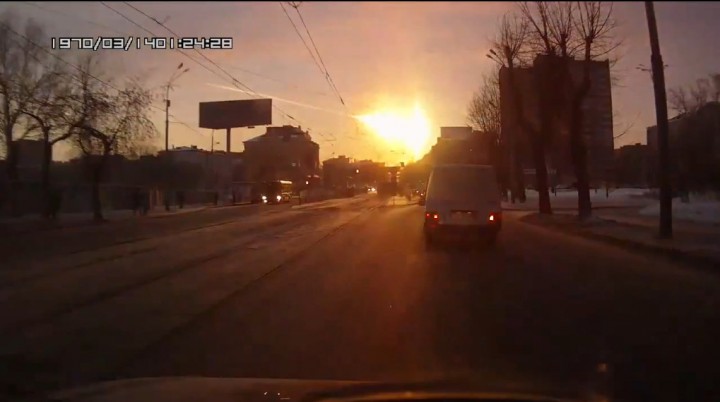 |
Figure 5 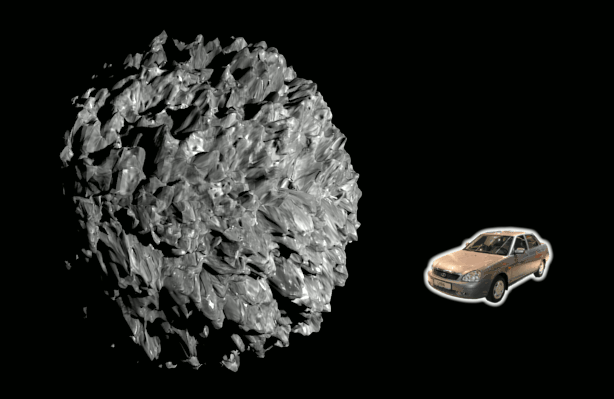 |
It is worth noting that during the week of Feb. 11-18, 2013, the number of celestial bodies falling to the Earth increased dramatically (in fact, anomalously). Bolides were seen in the skies of Russia, Kazakstan, Japan, Australia, Cuba, South Africa, Morocco, Germany, Switzerland, Italy, the Netherlands, Belgium, Britain, and Latvia. There were also peculiar silvery clouds, similar to those observed after the Tunguska meteorite impact. Perhaps Earth’s orbit was passing through an unknown meteor swarm at that time.
A crucial fact here is that the astronomers who were observing near-Earth space did not know about any meteor swarm. It was suggested that it could have been related to asteroid 2012 DA14, which passed by Earth on the evening of Feb. 15 at a distance of 28,000 km, but the trajectories of that asteroid and the Ural bolide were completely different. Thus, in February of this year the capabilities of modern Earth science to provide early detection of threats of cosmic origin were tested-and the results, unfortunately, proved totally unsatisfactory.
Surprisingly, the threat from outer space that had become apparent long before the fall of the Chebarkul meteoroid[1] was not taken seriously for a long time. In fact, only the directors of disaster movies were interested, and it was not seen as something really important by either politicians or the majority of scientists. It is possible-although it is unlikely that anyone will ever prove it-that there were quite earthly, political reasons for that situation. For example, it would seem logical that development of the Strategic Defense Initiative, as it was put forward by the United States during the Presidency of Ronald Reagan, would have to have inevitably led to the creation of at least an early warning system against threats from space intersecting Earth orbit.
But of course this did not occur. After the Cold War ended and the United States lost its main strategic adversary-an adversary which had spurred the development of the U.S. military and aerospace industry-people preferred to forget about the SDI. The price of this oblivion was the complete unpreparedness of the most technologically advanced countries on Earth to solve problems related to asteroid and comet threats.
Nonetheless, individual scientific teams have been doing research on the threat from asteroids and comets. There are about ten projects of different countries and organizations that have found 1,311 potentially hazardous asteroids (PHA). That calculation is based on observations from both ground- and space-based observatories, such as NASA’s WISE (Wide-field Infrared Survey Explorer).
Although Russia has a vital interest in technologies to prevent and protect against the asteroid and comet threats simply because of its vast territory, the western countries hold first place here. However, in Russia too, there have been and still are groups and organizations working on both technologies for early warning and possible strategies for planetary defense. Among these organizations are the Expert Working Group on Space Threats of the Russian Academy of Sciences’ Council on Space, which is part of the RAS Institute of Astronomy and is directly subordinate to Director of the Institute Boris Shustov; and a number of companies in the aerospace industry, primarily the S.A. Lavochkin Research and Production Association. The Aegis, AKO [Asteroid-Comet Danger], and Apophis special groups are under contract with the RAS Council on Space and with [the Russian space agency] Roscosmos. The following information is based mainly on materials from these organizations.
Possible Ways To Counter the Threat
In the entire history of observations, scientists have only once predicted a collision with a space body. This was asteroid 2008TC3, which observers discovered on Oct. 6, 2008, and within just 20 hours, in the early morning of Oct. 7, it exploded at an altitude of 37 km exactly where and when had been forecast: in the desert over northern Sudan, not far from the border with Egypt. The discovery was made using the 1.5 meter Catalina Sky Survey telescope. However, all experts agree that it would have been impossible in such a short time to destroy an asteroid or change its trajectory, even if it had been falling directly on New York City.
And then on March 2, 2009, a boulder with a diameter of 50 m flew by the Earth at a distance of 66,000 km-asteroid 2009 DD45. Had a collision with Earth occurred, it would have been a catastrophe several times worse than the Chelyabinsk incident. This asteroid was observed on Feb. 28-that is, three days before its passage-and by an amateur astronomer, not at a national observatory.
Obviously, the problem of preventing comet and asteroid threats has two components: a) improving the means of surveillance to allow (at least in theory) the detection of the most dangerous space objects in advance, and b) creating means of planetary defense.
The first task is completely solvable for large space bodies, such as the asteroid Apophis, whose dangerously close encounters with Earth are expected in 2029 and 2036 (Figure 6). Even in the case of Apophis, however, it is not absolutely certain that its orbit will not change as a result of factors not yet considered, and that it will not lead to a catastrophe on a planetary scale.
Figure 6 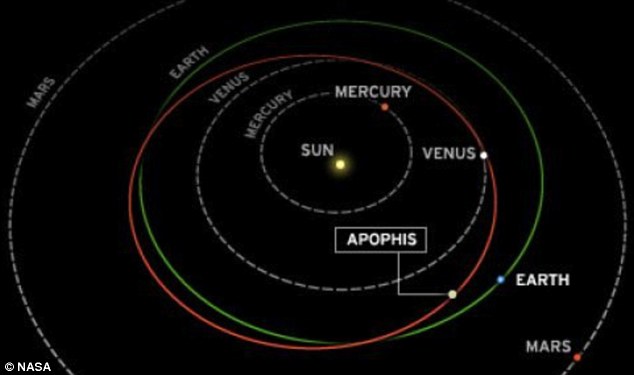 |
And it would be overly optimistic to assume that only Apophis constitutes a threat to our planet. The total number of undetected objects with a diameter of more than one kilometer is estimated by Russian scientists as “fewer than 40,” or less than 20% of the total number of potentially dangerous space bodies that are still unknown to mankind, but that “reside” in the Solar System. According to RAS Institute of Astronomy Director Boris Shustov, however, the total number of potentially Earth-threatening objects is between 200,000 and 300,000, and only 2% of those have currently been identified by astronomers (Figure 7).
Figure 7 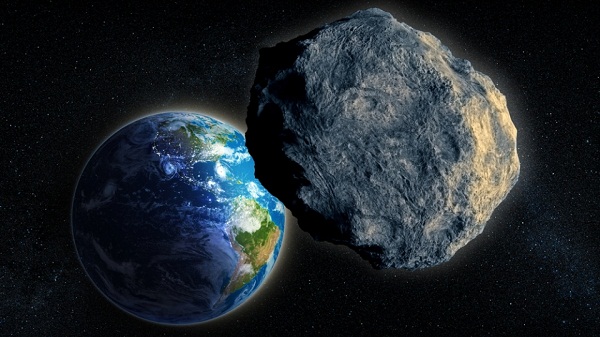 |
In order to detect even these “lost” objects, we need to significantly increase the effectiveness of currently available early warning systems. First of all, we need to create a single planetary network for detection and prediction of asteroid and comet hazards. The network should include both already existing centers-the Minor Planet Center (funded by NASA under the auspices of the International Astronomical Union), the Jet Propulsion Laboratory (United States), the laboratory of the University of Pisa (funded by the European Space Agency)-and also new ones, with the widest possible geographical coverage. It is absolutely necessary to establish the elements of such a network in the Southern Hemisphere. As for Russia, the work ongoing within individual institutes and research institutions should be systematically organized; a single coordination point has to be set up for data collection and processing. This center should be formed initially as a node of the global (supranational) network.
Of course satellite telescopes, such as those launched by NASA and the ESA, can be extremely advantageous. But, just as in creating a system of planetary defense, it should be clearly understood that such devices will only be effective if they become components of a global planetary strategy, not just individual projects. On March 12 of this year, speaking before the Federation Council of the Russian Federation, Boris Shustov identified the main problem facing Russian astronomy: the lack of funding. It will require at least 58 billion rubles (about $2 billion) to create a comprehensive program for protection against the asteroid and comet threat, he said. As we shall see, these figures are quite comparable to the cost of one ambitious NASA mission. For Russian science, however, this sum is extremely large. But the event in Chelyabinsk could play a positive role here.
Most regrettably, up to now, all the projects in the field of space security could be classified as part of a “passive” strategy of making observations and calculations about these dangerous objects. The only example I know of the influence of man on a space object, is the bombardment of the nucleus of comet Tempel-1 during NASA’s Deep Impact experiment, in the Summer of 2005. Russian experts do not rule out that in this experiment, while studying the comet and ways to intercept it, results were obtained that could be used to develop new types of weapons. The experience of intercepting the comet’s nucleus at a speed of about 10 km/s could be used to create BMD systems. It is possible that there was also testing of models of hypervelocity strikes, needed to assess the effectiveness of new kinetic weapons known as “Arrows of God” [in English also “Rods from God”].
However, even if this is so, there still does not exist a single approved mission including development of a “counterstrike” against an asteroid. The Apophis mission, which is being developed at the Lavochkin bureau, does not yet have clear deadlines (other than the obvious approximate time of the asteroid’s approach to Earth). Ten days ago the head of Roscosmos, Vladimir Popovkin, did say that NASA has proposed to Russia a joint project to capture and transport to lunar orbit a small asteroid (500 metric tons). The idea is to capture this object somewhere in outer space, and use tractor technology to pull it into lunar orbit, where it can be studied with the help of robots or even during manned expeditions.
However, as far as can be understood from an article in Aviation Week, this is not an approved project, but only an initiative for which NASA plans to request an additional $100 million appropriation. The project, developed by the Keck Institute for Space Studies, provides for the capture of the asteroid with a special “bag”; it would then be towed into an elliptical lunar orbit or to a Lagrange point in the Earth-Moon system. If the project is indeed approved, the cost could reach at least $2.65 billion. Technologically, such a capture might look like what is shown in (Figure 8).
Figure 8 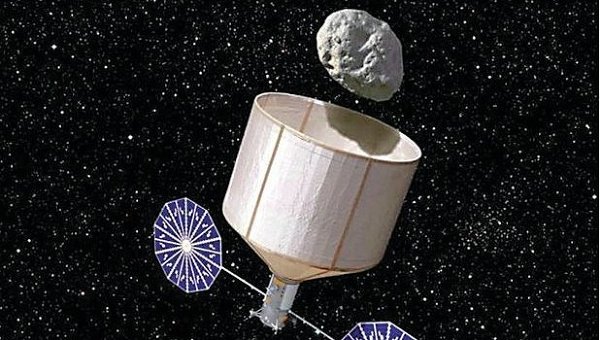 |
The possibility of countermeasures against potentially dangerous space objects, strictly speaking, comes down to two basic strategies: deflection and destruction. Deflection, of course, is preferable, since, first of all, the effects can be calculated more accurately, and secondly, because no irreversible actions are taken.
The means of deflection could be either soft (tractors, sails) or hard (targeted explosions, mine-laying, kinetic effects). The means of destruction involve powerful military technologies, including nuclear ones. This creates significant challenges for a planetary defense system, since using nuclear weapons in space could increase international tensions and create additional challenges to the security of the planet.
Therefore, we will have to proceed with a supranational project under the auspices of the UN. This is exactly what Russian Deputy Prime Minister Dmitri Rogozin, who was then still Russia’s representative to NATO, has said repeatedly,[2] in motivating the Russian initiative for an international project of global anti-missile and anti-asteroid planetary defense.
Rogozin’s Offer
Rogozin proposed the establishment of a civilian-military system for defense of the Earth from threats from outer space, of both military and natural origin, the latter in case of a dangerous approach to Earth by comets, asteroids, and other space objects.
Rogozin stressed that the idea of such a major project under the auspices of the UN, among other things, gives Russia an opportunity to seize the strategic initiative from the USA in deploying a global BMD system, including its segment in Europe. It will also make it possible to “package” a decision on establishing a truly unified and joint European missile defense system, into a major civilian project for space exploration, in which Russia has its own unique scientific, practical, and industrial role to play. Essentially, Russia and the United States could take on a noble mission to save the planet.
The draft initiative stated: “This humanitarian project for saving civilization pushes its military component to the background and places in a different light the role of the UN, which would have to become its ‘political sponsor.’ Planetary defense of the Earth could become an important stimulus for international research and military-industrial cooperation among the countries of the West and the BRICS, with a leading role for Russia.
“Those who decided to publicly reject participation in such a project would risk contempt in the eyes of the world, being perceived as short-sighted reactionaries, and even worse, as potential aggressors who are indifferent to the future of civilization and are pursuing narrowly national goals of domination in outer space.”
Given Rogozin’s increased political weight and authority, as well as his strong support from the Russian military-industrial complex, there is reason to hope that such a system will be a priority of the Russian space program in the next few years.
It should be noted that Russia definitely has something to offer in the creation of a global system of planetary defense. I am referring mainly to the Citadel system, developed at Lavochkin (Figure 9). This system was worked out “on paper” more than a dozen years ago; it was assumed then that it would take no more than 7-8 years to implement the hardware. The political decision to create the Citadel Planetary Defense System (PDS) was not made at that time, however, perhaps because it would have required effective cooperation among different countries and space agencies.
| Figure 9 Schematic of the Citadel Planetary Defense System 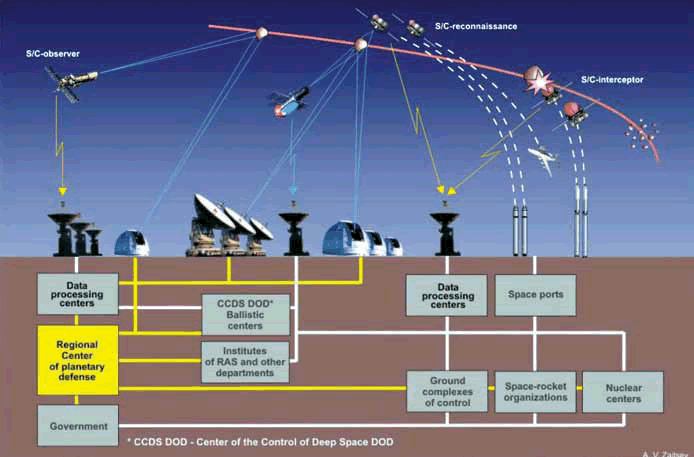 |
The Citadel PDS is a complex, layered system, but with fairly simple basic elements. Moreover, all its major elements (or their prototypes) were already developed in the Soviet Union.
These include many types of rocket and space technology, nuclear weapons, means of communication, navigation, and control, etc. Now we have a unique opportunity to use these tools, many of which were developed for military purposes, not for destruction, but to protect humanity from dangerous celestial bodies.
To prevent a collision of dangerous celestial bodies with Earth, the plan is to use interception, based on the infrastructure for space flights (space launch complexes, means of control, etc.). It will use, inclusively, special reconnaissance satellites and interceptor spacecraft capable of acting upon the dangerous celestial bodies.
Reconnaissance spacecraft are a small class of apparatuses, such as the American Clementine, created on the basis of SDI technology. The light weight of the reconnaissance spacecraft will allow them to accelerate to high speed and thus reach a dangerous celestial body faster than a heavy interceptor. During the flight to the object, they ascertain its characteristics and transfer the data to ground control, to refine the interception plan and its effect on the dangerous space body. After that, the necessary commands are communicated to the interceptor spacecraft, which maneuvers closer to the object and impacts it for the purpose of deflecting it from its Earth-bound trajectory or destroying it. Experience acquired during efforts to create missile defense may be useful for this. Kinetic impact or a nuclear explosion will be used against the dangerous object.
It is proposed that the basis of the planetary defense system will be the Citadel-1 operational reaction echelon, intended for protection against objects of less than 100 m in diameter-the type that most often collide with Earth. Due to their small size, their detection will be possible in the range of several days to several months before collision. This places severe restrictions on the timing to ready the interceptors, primarily the launch vehicles.
A Launch Vehicle Available
Currently these requirements are met by the Russian-Ukrainian launch vehicle (LV) Dnepr (a conversion of the RS-20 intercontinental ballistic missile, code-named SS-18 by NATO) and the Zenit LV. The time required for preparing to launch-from a few minutes with the Dnepr to 1.5 hours with the Zenit-makes them the only ones in the world that could be used in the operational reaction echelon.
The Russian-made launch vehicles have quite large capacities: if an interceptor is launched using the Zenit LV, the mass of a nuclear device delivered to the asteroid can be about 1,500 kg. The power of such a nuclear device would be no less than 1.5 megatons, which could destroy a stony asteroid [S-type asteroid] with a diameter of several hundred meters. If several blocks were docked in Earth orbit, the power of the nuclear device, and therefore the size of object to be destroyed, could be substantially increased.
Initially it was assumed that the basic spacecraft for creating reconnaissance satellites and interceptors could be vehicles such as the Mars-96 and Phobos-Grunt, developed at the Lavochkin bureau. However, quite a number of failures have plagued vehicles made by Lavochkin, significantly reducing the probability that the Citadel system will be built by the Russian space industry alone. Probably the best option would be combined missions, whereby Russia would provide the launch vehicles, and the spacecraft would be built by NASA and the ESA.
Interception of large asteroids and comets at great distances from the Earth will require implementation of a long-term response echelon, comparable to the function of the operational reaction echelon. There will, however, be important differences. In particular, these means of interception will generally not destroy dangerous space objects, but rather deflect them from a collision course with the Earth. Therefore, depending on the characteristics of the dangerous celestial body, its orbit, and the time available, not only nuclear devices but also others could be used to deflect it-kinetic (“Rods from God”), reactive, “space billiards,” etc. For this we will need to have large payloads of various types for assembly in Earth orbit of heavy interceptor satellites with multi-stage propulsion units.
Thus, to deflect cosmic threats will require resources from the whole world, and especially from countries possessing space and nuclear technologies (Russia, the United States, Western Europe, China, Japan, India).
There will obviously have to be a continuous cycle of project design and other work. This could be done on the “green wave” relay principle, whereby the results of work initiated in Europe, for example, would be continued in the Americas (after transmission over computer networks), followed by Asia, etc.
Of course, for such work to be quickly organized, mankind must prepare beforehand a kind of Mobilization Plan for the Defense of Earth, in case a threatening situation arises.
A base in resources, science, and technology will not ensure success in the fight against threats from space, unless we develop and implement a planet-wide strategy of indirect actions to avert threats. This shifts the problem of defense against asteroid and comet threats from the purely scientific domain to the political. We need to develop an effective strategy for systemic prevention/deflection of threats to the very existence of civilization on Earth. Otherwise, humanity will continue to play Russian roulette with the Cosmos, and in this game, as we all know, you cannot win every time.
Translated from Russian by Susan Welsh
[1] Lake Chebarkul in Chelyabinsk Region has been identified as the epicenter of the meteorite’s impact-ed.
[2] See EIR, May 11, 2012.
